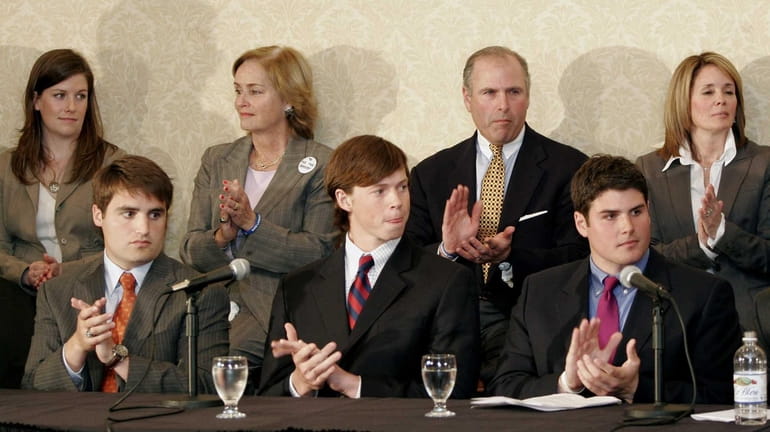Duke lacrosse scandal revisited in 'The Price of Silence'

Seated from left, Duke lacrosse players David Evans, Collin Finnerty and Reade Seligman at a news conference after being cleared of sexual assault charges on April 11, 2007. Credit: Getty Images / Grant Halverson
THE PRICE OF SILENCE: The Duke Lacrosse Scandal, the Power of the Elite, and the Corruption of Our Great Universities, by William D. Cohan. Scribner, 652 pp., $35.
Financial reporter William D. Cohan likes alpha males in troubled waters, and he wades into especially brackish murk for his new investigative book, "The Price of Silence: The Duke Lacrosse Sandal, the Power of the Elite and the Corruption of Our Great Universities."
The scandal grew out of a spring break party on March 13, 2006, for which the Blue Devils' varsity men's lacrosse team hired two strippers. One woman accused three players of raping her in the bathroom of the off-campus house shared by two co-captains.
Eight days later, historian William Chafe, a former dean of faculty, addressed the incident in the student newspaper. " 'Sex and race have always interacted in a vicious chemistry of power, privilege and control,' he wrote. 'Whether or not a rape took place . . . there is no question that racial epithets were hurled at black people. Nor is there any question that white students hired a black woman from an escort service to perform an exotic dance.' "
In truth, the students had requested white strippers, and there was some consternation when those who arrived were not to spec. The boozy night deteriorated into racial slurs and the brandishing of a broomstick with a threat to the dancers by a 21-year-old from Chevy Chase, Md.
And so begins an infuriating and squalid tale, with no heroes, several villains and an overstocked roster of victims. Before the month was out, the North Carolina Bureau of Investigation processed the accuser's clothing and rape kit and found nothing: no saliva, no semen, no blood. And yet the same day, Durham County Prosecutor Mike Nifong told a radio talk show that the DNA evidence would be "bulletproof."
For Duke itself, "The Price of Silence" was steep: $60 million to settle lawsuits brought by the three players indicted on charges of rape and later exonerated; $2 million to settle with 36 unindicted teammates. Three more are still seeking damages.
"Between the ruinous financial settlements and the cost of legal and public-relations advice, the cost to Duke -- in monetary terms -- of the March 13 party is said to be near $100 million," writes Cohan, a Duke graduate and contributing editor to Vanity Fair.
He is sharp about following the money, as demonstrated in his bestsellers "House of Cards," about the collapse of Bear Stearns, and "Money and Power," a portrait of Goldman Sachs. Duke lacrosse is a veritable feeder-system to Wall Street, an interesting tidbit in this sprawling book. Cohan receives extra points for fairness, but "The Price of Silence" is swamped by undigested quotations and meandering background. It would have been twice as good at half the length.
Still, some of the details sting, such as this: When one of the lacrosse party planners, Collin Finnerty of Garden City, graduated from Loyola University Maryland, he wore under his gown a silver medallion of St. Raymond, the patron saint of the falsely accused. It was a gift from Duke co-captain David Evans, whose DNA under the false fingernail of the accuser was never explained.
She was Crystal Gail Mangum, then a 27-year-old mother of two, who was convicted last November of stabbing her boyfriend to death. Cohan shows her story to have been wildly inconsistent from the first hours after the party, although she tells him she still rues not getting her day in court.
Class, race, alcohol, arrogance and schadenfreude were powerful accelerants that combusted at Duke, Cohan writes. Reporters all but danced around the flames; bloggers made their reputations on the story. After the case fell apart, prosecutor Nifong was disbarred, jailed for a day and driven into personal bankruptcy.
"How many times has an innocent person been charged with an offense and recovered millions of dollars because they were charged?" asked Ann Peterson, a lawyer in the Durham district attorney's office. "So what makes this case, and these kids, so exceptional and different from all of the other people who have been mistakenly charged with a criminal offense? Money."
That sentiment was underscored last month when The Washington Post published an exposé about a wrongful 1995 murder conviction secured by Nifong. Referring to the convicted man, the headline reads "Darryl Howard and the Rampaging Prosecutor: Durham learns little from the Lacrosse Debacle." It seems that after the conflagration at Duke died down, very few cared who else had been burned.
